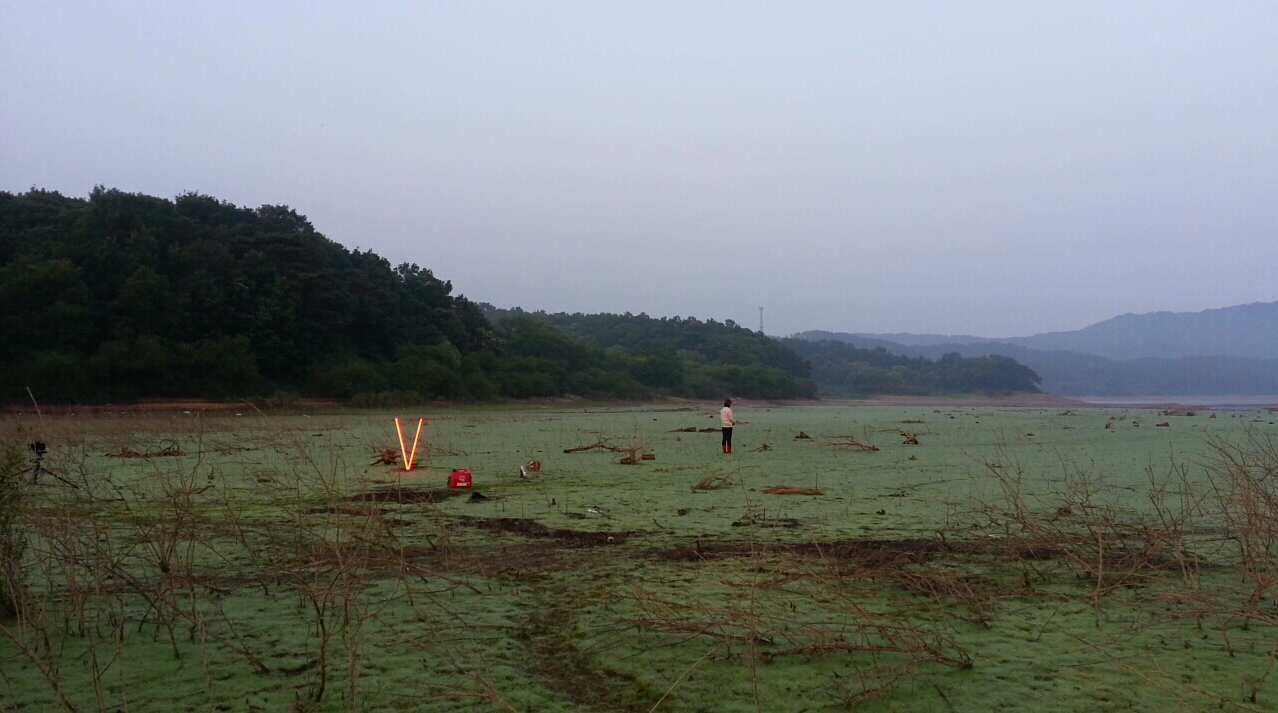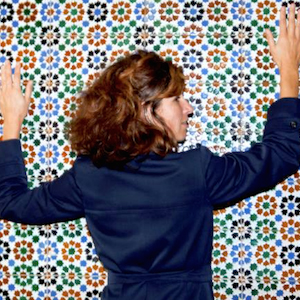Jung Lee (b.1972) was born and grew up in South Korea and studied fine art and photography in the UK. She says that because she studied in English, language became a crucial part of her work. ‘If my English had been perfect and good enough to fully express myself, I would never have been interested in language as a subject. My art stems from these combined experiences: as a foreign art student, a stranger in London, and also an observer of English language.’ The setting of her light installations might usually be in nature, yet the neon refers to all things urban. ‘I’m a typical city dweller, who is familiar with artificial lights and cultures in cities,’ Lee says. ‘I mean, I feel more comfortable with the signs of Starbucks or McDonald’s.’
Before she started her ongoing Aporia series in 2010, Lee created a project with a subtle political charge called Bordering North Korea (2005 - 08). She photographed the border areas into North Korea from China and South Korea, and inserted North Korean propagandistic phrases into the landscapes. ‘Whether my work is political or not, my artistic sensibilities have been affected by the division of Korea. It’s really special to be an artist in a divided nation,’ she says, adding that she appreciates the effect of it on her art practice. Bordering North Korea was a stepping-stone for the light installation series she is well known for. ‘For that project, I travelled a lot in bleak areas where lights were rare. These experiences were helpful for me to start actual light installations later on. Specifically the border areas between China and North Korea, which were fearful, as there were almost no lights. I was afraid of the darkness and tension. But even then, I imagined myself to be with the signs of Starbucks or McDonald’s, missing the familiar.’ Lee describes her work as a ‘reflection of my desire and imagination in desolate landscapes’. It is thoughtful and emotional and inspires viewers to develop their own thoughts and emotions. ‘I try to see my surroundings and even my emotions as an observer. I see myself as a person on the borderline. I believe that feeling out of place is helpful for my art.'
 However, from a meaningful phrase to photography is a long journey, and she uses diverse ways to find texts for her work: ‘Although I try to find simple and common expressions in our everyday life, I need some imagination in order to visualise an image of the text. It can come from various sources: Shakespeare’s sonnets, the songs of Queen, Korean modern poems and so on. I can embark on my work when some emotion and imagination can be added to the texts. After I sketch ideas considering the relationship between the neon texts and the landscapes, I design the texts and have them made in neon by an expert. Then, it is all about a photographic journey to make my visualisation come true in reality: locations, seasons, weather, atmosphere etc. As neon is delicate and fragile, I have to be cautious all through the journey. Although the process is daunting, it makes me feel more and more attached to the texts.’
However, from a meaningful phrase to photography is a long journey, and she uses diverse ways to find texts for her work: ‘Although I try to find simple and common expressions in our everyday life, I need some imagination in order to visualise an image of the text. It can come from various sources: Shakespeare’s sonnets, the songs of Queen, Korean modern poems and so on. I can embark on my work when some emotion and imagination can be added to the texts. After I sketch ideas considering the relationship between the neon texts and the landscapes, I design the texts and have them made in neon by an expert. Then, it is all about a photographic journey to make my visualisation come true in reality: locations, seasons, weather, atmosphere etc. As neon is delicate and fragile, I have to be cautious all through the journey. Although the process is daunting, it makes me feel more and more attached to the texts.’
The wonderful outcome of all these influences results in work that speaks a universal contemporary language. As mentioned, social media has proved to be a great help to overcome the geographical distance from South Korea, and enables people anywhere in the world to discover Lee’s work. It brings the artist fans, exhibitions and commissions – the Californian band Maroon 5 discovered Lee’s work this way, and asked her to create its fifth album cover. What matters most to Lee is that her work is shared and loved. ‘It makes me so happy. Although it’s derived from my experience, I want my work to evoke the viewer’s own feelings and emotions.’




Before she started her ongoing Aporia series in 2010, Lee created a project with a subtle political charge called Bordering North Korea (2005 - 08). She photographed the border areas into North Korea from China and South Korea, and inserted North Korean propagandistic phrases into the landscapes. ‘Whether my work is political or not, my artistic sensibilities have been affected by the division of Korea. It’s really special to be an artist in a divided nation,’ she says, adding that she appreciates the effect of it on her art practice. Bordering North Korea was a stepping-stone for the light installation series she is well known for. ‘For that project, I travelled a lot in bleak areas where lights were rare. These experiences were helpful for me to start actual light installations later on. Specifically the border areas between China and North Korea, which were fearful, as there were almost no lights. I was afraid of the darkness and tension. But even then, I imagined myself to be with the signs of Starbucks or McDonald’s, missing the familiar.’ Lee describes her work as a ‘reflection of my desire and imagination in desolate landscapes’. It is thoughtful and emotional and inspires viewers to develop their own thoughts and emotions. ‘I try to see my surroundings and even my emotions as an observer. I see myself as a person on the borderline. I believe that feeling out of place is helpful for my art.'

The wonderful outcome of all these influences results in work that speaks a universal contemporary language. As mentioned, social media has proved to be a great help to overcome the geographical distance from South Korea, and enables people anywhere in the world to discover Lee’s work. It brings the artist fans, exhibitions and commissions – the Californian band Maroon 5 discovered Lee’s work this way, and asked her to create its fifth album cover. What matters most to Lee is that her work is shared and loved. ‘It makes me so happy. Although it’s derived from my experience, I want my work to evoke the viewer’s own feelings and emotions.’













